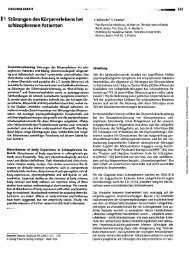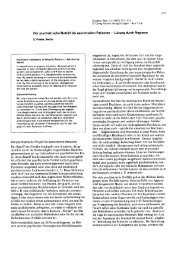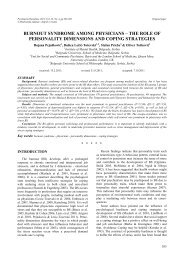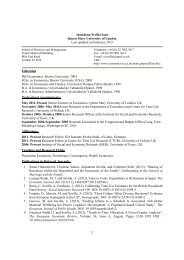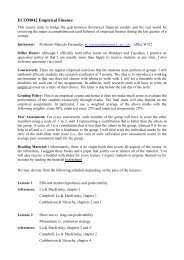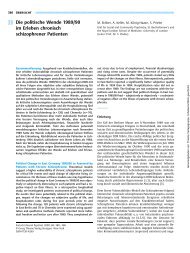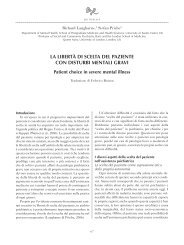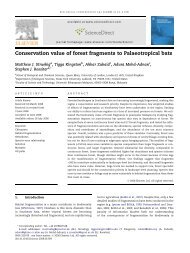Proofs - Personal Webspace for QMUL - Queen Mary, University of ...
Proofs - Personal Webspace for QMUL - Queen Mary, University of ...
Proofs - Personal Webspace for QMUL - Queen Mary, University of ...
You also want an ePaper? Increase the reach of your titles
YUMPU automatically turns print PDFs into web optimized ePapers that Google loves.
on the availability <strong>of</strong> service usage data by all patients. In Germany<br />
and Austria, only in emergency departments usability fi gures had<br />
been based on data (<strong>for</strong> the other services, registers had been<br />
based on estimates), in Denmark, no data- based fi gures were<br />
available <strong>for</strong> any <strong>of</strong> the nine primary care services interviewed,<br />
and Finland only kept such data in the mental health services.<br />
The order <strong>for</strong> the availability <strong>of</strong> data about service usage<br />
among immigrant patients differed from that <strong>for</strong> all patients.<br />
One in four <strong>of</strong> the mental health services (12 services) registered<br />
data on service usage by immigrant patients separately. This was<br />
the case <strong>for</strong> 19% <strong>of</strong> emergency departments (9 services) and only<br />
10% <strong>of</strong> primary care services (14 services).<br />
Only 15% <strong>of</strong> the fi gures on immigrant patients were based<br />
on actual data, while 69% were based on estimates and 16% <strong>of</strong><br />
pr<strong>of</strong>essionals interviewed did not provide any general fi gures on<br />
the number <strong>of</strong> immigrant patients. There was again considerable<br />
variation in the availability <strong>of</strong> data registers across countries. The<br />
highest numbers <strong>of</strong> services collecting data on immigrant patients<br />
were in Spain (9 out <strong>of</strong> 15 services interviewed) and Sweden (6 out<br />
<strong>of</strong> 15 services interviewed), whereas in Austria, Belgium, Denmark,<br />
France, Germany and the Netherlands, none <strong>of</strong> the services interviewed<br />
collected data on service use by immigrant patients.<br />
From a country- level perspective: eight countries had at<br />
least one service interviewed that collected data on service use<br />
by refugees, while seven countries reported as least one service<br />
with data on asylum seekers, six countries <strong>for</strong> victims <strong>of</strong> human<br />
traffi cking and 11 countries <strong>for</strong> irregular immigrants.<br />
6.2. In<strong>for</strong>mation on the use <strong>of</strong> services<br />
Despite the relative sizes <strong>of</strong> these services, the highest proportion<br />
<strong>of</strong> immigrant patients was found in the mental health<br />
services (23%), followed by 16% <strong>for</strong> primary care services and 13%<br />
<strong>for</strong> emergency departments. There was no overall pattern across<br />
the participating countries. Taking all the services into account,<br />
the average reported number <strong>of</strong> immigrant patients was higher<br />
in Austria, the Netherlands and Sweden. For emergency departments,<br />
this was the case again <strong>for</strong> Austria and the Netherlands,<br />
as well as <strong>for</strong> Greece. In primary care services, the number <strong>of</strong><br />
immigrant patients was especially high in France, Germany and<br />
the Netherlands. For mental health services immigrant patient<br />
numbers were high <strong>for</strong> Greece, the Netherlands, and Sweden<br />
compared with the other participating countries.<br />
6.3. Interpreting services<br />
The dataset distinguished between three different types <strong>of</strong><br />
interpreting services: 1) direct/face- to- face interpreting services,<br />
2) telephone interpreting services, and 3) a mix <strong>of</strong> other kinds<br />
U. Kluge et al. / European Psychiatry 27 (2012) / supplement n°2 / S56-S62 S59<br />
<strong>of</strong> interpreting services, such as bilingual staff and mediators.<br />
53% <strong>of</strong> services never provided any direct interpreting service,<br />
and 59% <strong>of</strong> responding services never provided a telephone<br />
interpreting service. In addition, 24% <strong>of</strong> the responding services<br />
reported always using direct interpreting service <strong>for</strong> patients<br />
with language diffi culties, and only 17% <strong>of</strong> services always used<br />
a telephone interpreting service when language barriers were<br />
present. For fi gures on the frequency <strong>of</strong> availability <strong>of</strong> direct and<br />
telephone interpreting services see Table 2.<br />
The availability <strong>of</strong> in<strong>for</strong>mation on interpreting services<br />
within the three types <strong>of</strong> services studied varied across countries.<br />
Altogether 101 out <strong>of</strong> the 240 services (42%) did not provide<br />
any <strong>for</strong>m <strong>of</strong> interpreting service. In Finland, Sweden and the<br />
UK, all interviewed services provided some kind <strong>of</strong> interpreting<br />
service. In Denmark, the Netherlands and Spain, 14 out <strong>of</strong> the<br />
15 services had interpreting services available <strong>for</strong> immigrant<br />
patients. In Greece, no interpreting service use was reported in<br />
any <strong>of</strong> the services, whilst in Lithuania only two services <strong>of</strong>fered<br />
some type <strong>of</strong> interpreting service. By contrast, in Spain, three<br />
services <strong>of</strong>fered all the three types <strong>of</strong> interpreting service listed<br />
above (direct, telephone and mixed), followed by Belgium and<br />
Germany with two services providing all three types <strong>of</strong> interpreting<br />
service. All <strong>of</strong> the interviewed services in the UK had access<br />
to two different types <strong>of</strong> interpreting service. The same was the<br />
case <strong>for</strong> 14 <strong>of</strong> the 15 services in Sweden and 10 <strong>of</strong> the15 services<br />
in Germany. In Denmark, at least 14 <strong>of</strong> the 15 services provided<br />
one or more <strong>of</strong> the types <strong>of</strong> interpreting service.<br />
In addition to these fi gures, differences were noted between<br />
the countries regarding access and use <strong>of</strong> telephone interpreting<br />
services, which were absent in some <strong>of</strong> the participating<br />
countries. For all the services in Austria, Greece and Poland there<br />
was no access to such service, and in Germany and Hungary it<br />
was only <strong>of</strong>fered by one service <strong>of</strong> the 15 interviewed.<br />
Except Greece, where there was no interpreting service<br />
at all, all other countries had at least one service with a direct<br />
interpreting service.<br />
Mental health services most <strong>of</strong>ten provided direct interpreting<br />
services (35%), followed by emergency departments (23%)<br />
and primary care services (20%). Emergency services had a higher<br />
proportion <strong>of</strong> telephone interpreting service use, as time critical<br />
care cannot wait <strong>for</strong> an interpreter to arrive, whilst mental health<br />
services provided telephone interpreting services less <strong>of</strong>ten than<br />
either <strong>of</strong> the other two types <strong>of</strong> service.<br />
<strong>Pro<strong>of</strong>s</strong><br />
6.4. Staff members with immigrant background<br />
For the 240 services interviewed in this study, 147 (61%) stated<br />
that they employed individuals with immigrant backgrounds<br />
among their staff. A quarter <strong>of</strong> those that did (16% <strong>of</strong> the total) had<br />
only one member <strong>of</strong> staff with an immigrant background. Eighty<br />
Table 2<br />
Responses given <strong>for</strong> how <strong>of</strong>ten direct and telephone interpreting services were used <strong>for</strong> patients with a language barrier.<br />
Type <strong>of</strong> interpreting service Never used Sometimes used Always used<br />
Direct interpreting service (n=239) 53% (128) 23% (54) 24% (57)<br />
Telephone interpreting service (n=211) 59% (124) 24% (50) 17% (37)




